Unit 5 What are the shirts made ofPeriod 4(Section B 2a-2e)课件(共16张PPT)
文档属性
| 名称 | Unit 5 What are the shirts made ofPeriod 4(Section B 2a-2e)课件(共16张PPT) | 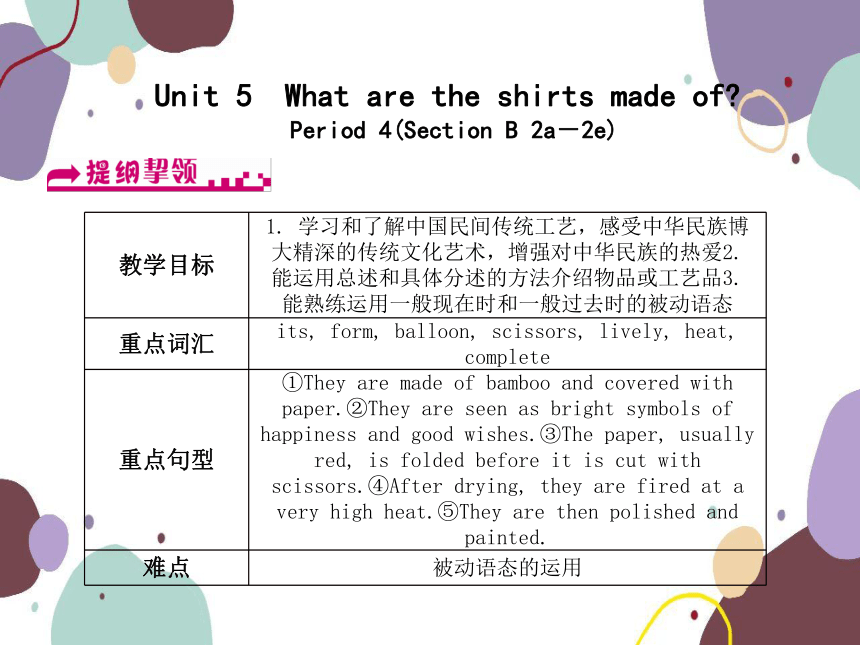 | |
| 格式 | pptx | ||
| 文件大小 | 231.4KB | ||
| 资源类型 | 教案 | ||
| 版本资源 | 人教新目标(Go for it)版 | ||
| 科目 | 英语 | ||
| 更新时间 | 2022-10-22 15:35:14 | ||
图片预览


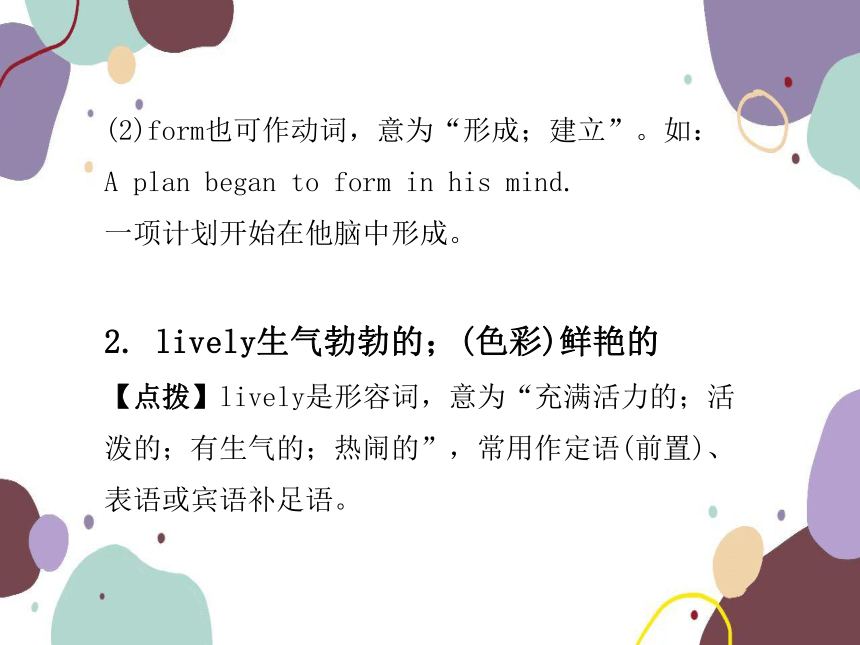
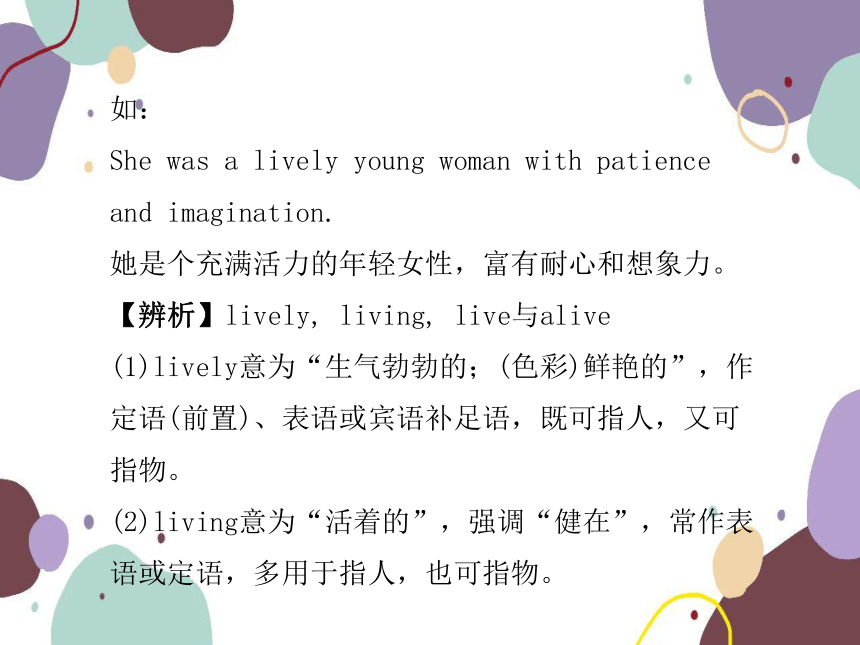
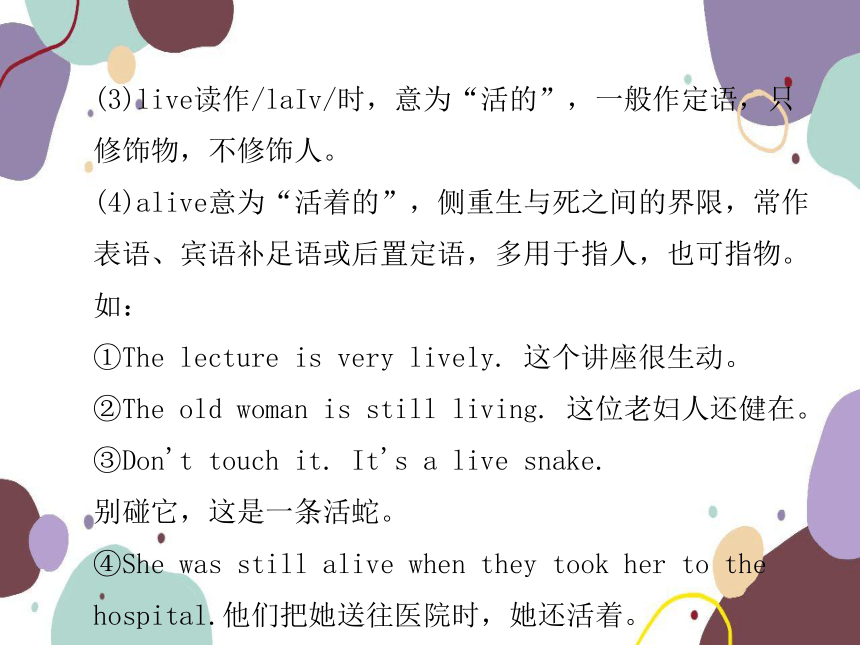
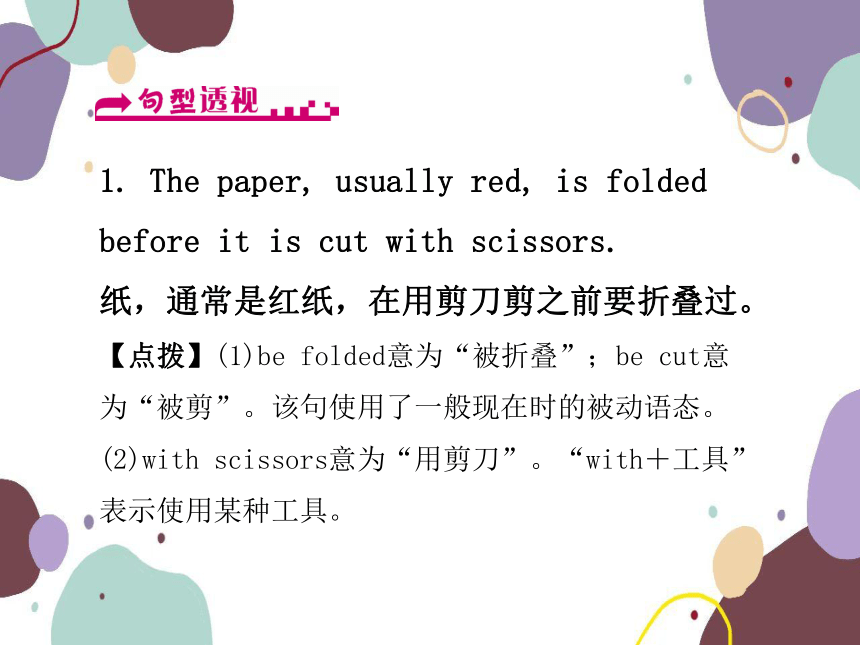
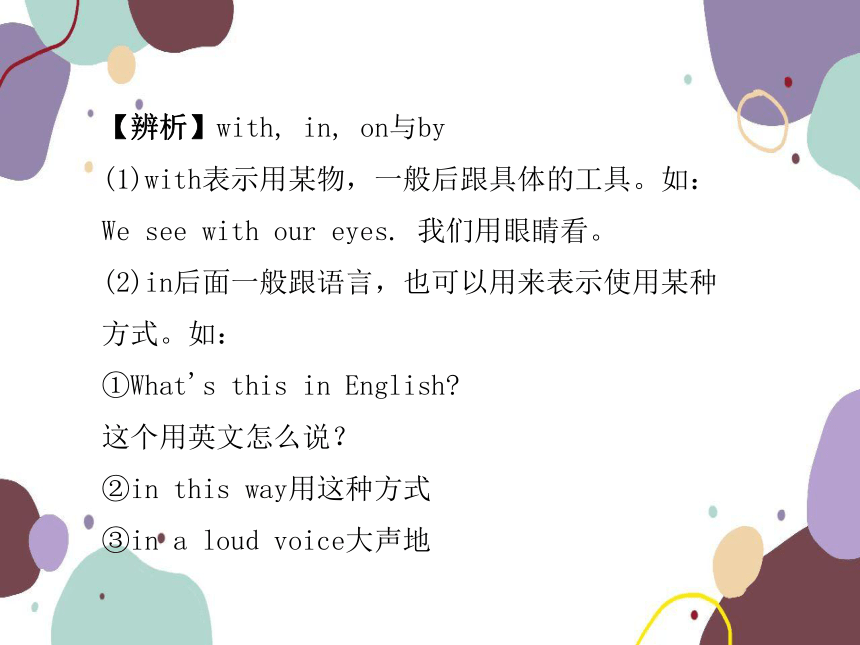
文档简介
(共16张PPT)
Unit 5 What are the shirts made of
Period 4(Section B 2a-2e)
教学目标 1. 学习和了解中国民间传统工艺,感受中华民族博大精深的传统文化艺术,增强对中华民族的热爱2. 能运用总述和具体分述的方法介绍物品或工艺品3. 能熟练运用一般现在时和一般过去时的被动语态
重点词汇 its, form, balloon, scissors, lively, heat, complete
重点句型 ①They are made of bamboo and covered with paper.②They are seen as bright symbols of happiness and good wishes.③The paper, usually red, is folded before it is cut with scissors.④After drying, they are fired at a very high heat.⑤They are then polished and painted.
难点 被动语态的运用
1. form形式;类型
【点拨】form作名词时,意为“形式;类型”。如:
Ice, snow and steam are different forms of water.
冰、雪和水蒸气是水的不同形态。
【延伸】(1)form作名词时还意为“表格”。如:
He is filling in a form.
他正在填写一张表格。
(2)form也可作动词,意为“形成;建立”。如:
A plan began to form in his mind.
一项计划开始在他脑中形成。
2. lively生气勃勃的;(色彩)鲜艳的
【点拨】lively是形容词,意为“充满活力的;活泼的;有生气的;热闹的”,常用作定语(前置)、表语或宾语补足语。
如:
She was a lively young woman with patience and imagination.
她是个充满活力的年轻女性,富有耐心和想象力。
【辨析】lively, living, live与alive
(1)lively意为“生气勃勃的;(色彩)鲜艳的”,作定语(前置)、表语或宾语补足语,既可指人,又可指物。
(2)living意为“活着的”,强调“健在”,常作表语或定语,多用于指人,也可指物。
(3)live读作/laIv/时,意为“活的”,一般作定语,只修饰物,不修饰人。
(4)alive意为“活着的”,侧重生与死之间的界限,常作表语、宾语补足语或后置定语,多用于指人,也可指物。如:
①The lecture is very lively. 这个讲座很生动。
②The old woman is still living. 这位老妇人还健在。
③Don't touch it. It's a live snake.
别碰它,这是一条活蛇。
④She was still alive when they took her to the hospital.他们把她送往医院时,她还活着。
1. The paper, usually red, is folded before it is cut with scissors.
纸,通常是红纸,在用剪刀剪之前要折叠过。
【点拨】(1)be folded意为“被折叠”;be cut意为“被剪”。该句使用了一般现在时的被动语态。
(2)with scissors意为“用剪刀”。“with+工具”表示使用某种工具。
【辨析】with, in, on与by
(1)with表示用某物,一般后跟具体的工具。如:
We see with our eyes. 我们用眼睛看。
(2)in后面一般跟语言,也可以用来表示使用某种方式。如:
①What's this in English
这个用英文怎么说?
②in this way用这种方式
③in a loud voice大声地
(3)on主要是表通讯。如:
①Let's talk on the phone.我们在电话里聊吧。
②on TV/the radio/the Internet
在电视上/收音机上/网上
(4)by表示方式或手段,通常用于交通工具的使用。如:
①We often go to school by bus/car/bike/train.
我们经常坐公交车/坐小汽车/骑自行车/坐火车去上学。
②by e-mail通过电子邮件
③I study English by listening to the tapes.
我通过听磁带学英语。
【延伸】乘坐交通工具的常用表达:by air=by plane=in the plane坐飞机; by car=in the car坐小汽车;by bike/bus/train/subway=on the bike/bus/train/subway骑自行车/坐公交车/火车/地铁;on foot步行。
2. They are seen as bright symbols of happiness and good wishes.
它们被看作幸福和美好祝愿的鲜明象征。
【点拨】(1)be seen as意为“被看作”,see意为“看见”。如:
①Can you see the stars in the sky
你能看到天空中的星星吗?
②He is often seen to play soccer in the park.
他经常被看到在公园里踢足球。
【辨析】watch, look, see与read
这四个词都有“看”的意思,但“看”法不同:
(1)watch强调看正在运动或变化的事物,有时含有“欣赏”之意。如:
Do you watch TV at night 你晚上看电视吗?
(2)look强调看这个动作,不强调是否看见,后接宾语时,与at连用。如:
Look at the blackboard, please.请看黑板。
(3)see强调看的结果,表示“看见;看到”。如:
We saw a wonderful film yesterday.
昨天我们看了一场精彩的电影。
(4)read强调看书、报、杂志等。如:
I like reading books at home.
我喜欢在家看书。
【延伸】有些被动语态构成了习惯用法或习语。如:It is said that... 据说……; It is reported that... 据报道(有人报道)……; It is well known that... 众所周知……。
【点拨】(2)symbols of.../a symbol of...意为“……的象征”。如:
Long noodles are a symbol of long life.
长长的面条是长寿的象征。
【点拨】(3)happiness是名词,意为“幸福;高兴”,是由形容词happy在词尾加后缀-ness构成的名词。如:
Money can't buy happiness.
金钱买不来幸福。
【延伸】形容词加后缀-ness构成的名词还有:
busy(忙的)—business(商业;事务)
ill(病的)—illness(疾病)
kind(亲切的;和蔼的)—kindness(仁慈;好意)
dark(黑暗的)—darkness(黑暗)
【注意】happy(adj.幸福的)→变y为i再加-ness→happiness(n.幸福)
【点拨】(4)wish是名词,常用复数形式wishes,意为“祝福;愿望”。
如:
①Please send my best wishes to your parents.
请代我问候你的父母。
②My wish is to become a teacher.
我的愿望是当一名教师。
【延伸】wish也可作及物动词,意为“希望”。如:
①I wish to have a holiday.
我希望有一个假期。
②We wish to live in a big house with a big garden.我们希望住在一座带有大花园的大房子里。
③I wish that I could fly like a bird.
我希望自己能像鸟儿一样飞翔。
【注意】wish后能接双宾语,构成短语wish sb. sth.,表示祝愿,而hope不能。如:
We wish you a happy new year!(正)
我们祝你新年快乐!
We hope you a happy new year!(误)
我们祝你新年快乐!
Unit 5 What are the shirts made of
Period 4(Section B 2a-2e)
教学目标 1. 学习和了解中国民间传统工艺,感受中华民族博大精深的传统文化艺术,增强对中华民族的热爱2. 能运用总述和具体分述的方法介绍物品或工艺品3. 能熟练运用一般现在时和一般过去时的被动语态
重点词汇 its, form, balloon, scissors, lively, heat, complete
重点句型 ①They are made of bamboo and covered with paper.②They are seen as bright symbols of happiness and good wishes.③The paper, usually red, is folded before it is cut with scissors.④After drying, they are fired at a very high heat.⑤They are then polished and painted.
难点 被动语态的运用
1. form形式;类型
【点拨】form作名词时,意为“形式;类型”。如:
Ice, snow and steam are different forms of water.
冰、雪和水蒸气是水的不同形态。
【延伸】(1)form作名词时还意为“表格”。如:
He is filling in a form.
他正在填写一张表格。
(2)form也可作动词,意为“形成;建立”。如:
A plan began to form in his mind.
一项计划开始在他脑中形成。
2. lively生气勃勃的;(色彩)鲜艳的
【点拨】lively是形容词,意为“充满活力的;活泼的;有生气的;热闹的”,常用作定语(前置)、表语或宾语补足语。
如:
She was a lively young woman with patience and imagination.
她是个充满活力的年轻女性,富有耐心和想象力。
【辨析】lively, living, live与alive
(1)lively意为“生气勃勃的;(色彩)鲜艳的”,作定语(前置)、表语或宾语补足语,既可指人,又可指物。
(2)living意为“活着的”,强调“健在”,常作表语或定语,多用于指人,也可指物。
(3)live读作/laIv/时,意为“活的”,一般作定语,只修饰物,不修饰人。
(4)alive意为“活着的”,侧重生与死之间的界限,常作表语、宾语补足语或后置定语,多用于指人,也可指物。如:
①The lecture is very lively. 这个讲座很生动。
②The old woman is still living. 这位老妇人还健在。
③Don't touch it. It's a live snake.
别碰它,这是一条活蛇。
④She was still alive when they took her to the hospital.他们把她送往医院时,她还活着。
1. The paper, usually red, is folded before it is cut with scissors.
纸,通常是红纸,在用剪刀剪之前要折叠过。
【点拨】(1)be folded意为“被折叠”;be cut意为“被剪”。该句使用了一般现在时的被动语态。
(2)with scissors意为“用剪刀”。“with+工具”表示使用某种工具。
【辨析】with, in, on与by
(1)with表示用某物,一般后跟具体的工具。如:
We see with our eyes. 我们用眼睛看。
(2)in后面一般跟语言,也可以用来表示使用某种方式。如:
①What's this in English
这个用英文怎么说?
②in this way用这种方式
③in a loud voice大声地
(3)on主要是表通讯。如:
①Let's talk on the phone.我们在电话里聊吧。
②on TV/the radio/the Internet
在电视上/收音机上/网上
(4)by表示方式或手段,通常用于交通工具的使用。如:
①We often go to school by bus/car/bike/train.
我们经常坐公交车/坐小汽车/骑自行车/坐火车去上学。
②by e-mail通过电子邮件
③I study English by listening to the tapes.
我通过听磁带学英语。
【延伸】乘坐交通工具的常用表达:by air=by plane=in the plane坐飞机; by car=in the car坐小汽车;by bike/bus/train/subway=on the bike/bus/train/subway骑自行车/坐公交车/火车/地铁;on foot步行。
2. They are seen as bright symbols of happiness and good wishes.
它们被看作幸福和美好祝愿的鲜明象征。
【点拨】(1)be seen as意为“被看作”,see意为“看见”。如:
①Can you see the stars in the sky
你能看到天空中的星星吗?
②He is often seen to play soccer in the park.
他经常被看到在公园里踢足球。
【辨析】watch, look, see与read
这四个词都有“看”的意思,但“看”法不同:
(1)watch强调看正在运动或变化的事物,有时含有“欣赏”之意。如:
Do you watch TV at night 你晚上看电视吗?
(2)look强调看这个动作,不强调是否看见,后接宾语时,与at连用。如:
Look at the blackboard, please.请看黑板。
(3)see强调看的结果,表示“看见;看到”。如:
We saw a wonderful film yesterday.
昨天我们看了一场精彩的电影。
(4)read强调看书、报、杂志等。如:
I like reading books at home.
我喜欢在家看书。
【延伸】有些被动语态构成了习惯用法或习语。如:It is said that... 据说……; It is reported that... 据报道(有人报道)……; It is well known that... 众所周知……。
【点拨】(2)symbols of.../a symbol of...意为“……的象征”。如:
Long noodles are a symbol of long life.
长长的面条是长寿的象征。
【点拨】(3)happiness是名词,意为“幸福;高兴”,是由形容词happy在词尾加后缀-ness构成的名词。如:
Money can't buy happiness.
金钱买不来幸福。
【延伸】形容词加后缀-ness构成的名词还有:
busy(忙的)—business(商业;事务)
ill(病的)—illness(疾病)
kind(亲切的;和蔼的)—kindness(仁慈;好意)
dark(黑暗的)—darkness(黑暗)
【注意】happy(adj.幸福的)→变y为i再加-ness→happiness(n.幸福)
【点拨】(4)wish是名词,常用复数形式wishes,意为“祝福;愿望”。
如:
①Please send my best wishes to your parents.
请代我问候你的父母。
②My wish is to become a teacher.
我的愿望是当一名教师。
【延伸】wish也可作及物动词,意为“希望”。如:
①I wish to have a holiday.
我希望有一个假期。
②We wish to live in a big house with a big garden.我们希望住在一座带有大花园的大房子里。
③I wish that I could fly like a bird.
我希望自己能像鸟儿一样飞翔。
【注意】wish后能接双宾语,构成短语wish sb. sth.,表示祝愿,而hope不能。如:
We wish you a happy new year!(正)
我们祝你新年快乐!
We hope you a happy new year!(误)
我们祝你新年快乐!
同课章节目录
- Unit 1 How can we become good learners.
- Section A
- Section B
- Unit 2 I think that mooncakes are delicious!
- Section A
- Section B
- Unit 3 Could you please tell me where the restroom
- Section A
- Section B
- Unit 4 I used to be afraid of the dark.
- Section A
- Section B
- Unit 5 What are the shirts made of?
- Section A
- Section B
- Review of Units 1-5
- Unit 6 When was it invented?
- Section A
- Section B
- Unit 7 Teenagers should be allowed to choose their
- Section A
- Section B
- Unit 8 It must belong to Carla.
- Section A
- Section B
- Unit 9 I like music that I can dance to.
- Section A
- Section B
- Unit 10 You're supposed to shake hands.
- Section A
- Section B
- Review of Units 6-10
- Unit 11 Sad movies make me cry.
- Section A
- Section B
- Unit 12 Life is full of the unexpected
- Section A
- Section B
- Unit 13 We're trying to save the earth!
- Section A
- Section B
- Unit 14 I remember meeting all of you in Grade 7.
- Section A
- Section B
- Review of Units 11-14
